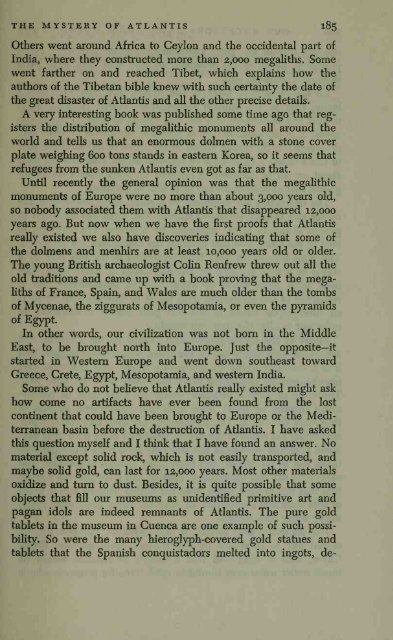Create successful ePaper yourself
Turn your PDF publications into a flip-book with our unique Google optimized e-Paper software.
THE MYSTERY OF ATLANTIS 185<br />
Others went around Africa to Ceylon and the occidental part of<br />
India, where they constructed more than 2,000 megaliths. Some<br />
went farther on and reached Tibet, which explains how the<br />
authors of the Tibetan bible knew with such certainty the date of<br />
the great disaster of Atlantis and all the other precise details.<br />
A very interesting book was published some time ago that registers<br />
the distribution of megalithic monuments all around the<br />
world and tells us that an enormous dolmen with a stone cover<br />
plate weighing 600 tons stands in eastern Korea, so it seems that<br />
refugees from the sunken Atlantis even got as far as that.<br />
Until recently the general opinion was that the megalithic<br />
monuments of Europe were no more than about 3,000 years old,<br />
so nobody associated them v^dth Atlantis that disappeared 12,000<br />
years ago. But now when we have the first<br />
really existed we also have discoveries<br />
proofs that Atlantis<br />
indicating that some of<br />
the dolmens and menhirs are at least 10,000 years old or older.<br />
The young British archaeologist Colin Renfrew threw out all the<br />
old traditions and came up with a book proving that the megaliths<br />
of France, Spain, and Wales are much older than the tombs<br />
of Mycenae, the ziggurats of Mesopotamia, or even the pyramids<br />
of Egypt.<br />
In other words, our civilization<br />
was not bom in the Middle<br />
East, to be brought north into Europe. Just the opposite—it<br />
started in Western Europe and went down southeast toward<br />
Greece, Crete, Egypt, Mesopotamia, and western India.<br />
Some who do not believe that Atlantis really existed might ask<br />
how come no artifacts have ever been found from the lost<br />
continent that could have been brought to Europe or the Mediterranean<br />
basin before the destruction of Atlantis. I have asked<br />
this question myself and I think that I have found an answer. No<br />
material except solid rock, which is not easily transported, and<br />
maybe solid gold, can last for 12,000 years. Most other materials<br />
oxidize and turn to dust. Besides, it is quite possible that some<br />
objects that fill our museums as unidentified primitive art and<br />
pagan idols are indeed remnants of Atlantis. The pure gold<br />
tablets in the museum in Cuenca are one example of such possibility.<br />
So were the many hieroglyph-covered gold statues and<br />
tablets that the Spanish conquistadors melted into ingots, de-

















